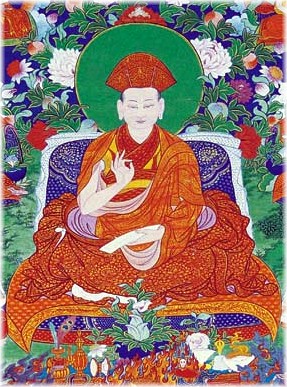Pema Karpo: Difference between revisions
Jump to navigation
Jump to search
No edit summary |
No edit summary |
||
| Line 10: | Line 10: | ||
*Michael Broido, 'Padma Dkar-po on Intergration as Ground, Path and Goal' in ''The Journal of the Tibet Society'', Volume 5, 1985 | *Michael Broido, 'Padma Dkar-po on Intergration as Ground, Path and Goal' in ''The Journal of the Tibet Society'', Volume 5, 1985 | ||
*Michael Broido, 'Padma Dkar-po on the Two Sātyas' in ''Journal of the International Association of Buddhist Studies'' 8.2, 1985 | *Michael Broido, 'Padma Dkar-po on the Two Sātyas' in ''Journal of the International Association of Buddhist Studies'' 8.2, 1985 | ||
*Padma Karpo Ngawang Norbu, ''The Practice of the Co-Emergent Mahamudra'', translated by Ven. Anzan Hoshin sensei, Ottawa: Great Matter Publications, 1991 | |||
==Internal Links== | ==Internal Links== | ||
Revision as of 14:18, 4 August 2008

Künkhyen Pema Karpo (Wyl. pad ma dkar po) (1527-1592) – the fourth Gyalwang Drukpa. He was a great master of the Drukpa Kagyü school.
Writings
He composed 24 volumes of writings including a history of Buddhism and commentary on the Bodhicharyavatara.
Further Reading
- E. Gene Smith, 'Padma dkar po and His History of Buddhism' in Among Tibetan Texts, Boston: Wisdom, 2001
- Michael Broido, 'Padma Dkar-po on Tantra as Ground, Path and Goal' in The Journal of the Tibet Society, Volume 4, 1984
- Michael Broido, 'Padma Dkar-po on Intergration as Ground, Path and Goal' in The Journal of the Tibet Society, Volume 5, 1985
- Michael Broido, 'Padma Dkar-po on the Two Sātyas' in Journal of the International Association of Buddhist Studies 8.2, 1985
- Padma Karpo Ngawang Norbu, The Practice of the Co-Emergent Mahamudra, translated by Ven. Anzan Hoshin sensei, Ottawa: Great Matter Publications, 1991